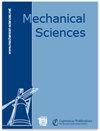Surface quality improvement for 316L additive manufactured prototype based on magnetorheological polishing
IF 1.5
4区 工程技术
Q4 ENGINEERING, MECHANICAL
引用次数: 0
Abstract
Abstract. Additive manufacturing has attracted increasing attention in recent years due to its flexibility and near-net shaping advantages. Although recent advancements in metal additive manufacturing accuracy have met the post-processing requirement for dimensional tolerance, the finishing post-processing of functional surfaces must be further investigated in conjunction with material characteristics. This research aims to investigate the use of a flexible process in the polishing of additive molding samples. As an example, the surface of a 316L stainless steel sample formed by powder bed laser melting was polished using magnetorheological polishing technology. Magnetic field simulation was used to create a longitudinally staggered magnetorheological polishing tool. Surface roughness and residual stress were studied with process parameters such as abrasive content, magnetic particle content, machining gap, and spindle speed. Results show that the polishing effect is better at 4 % and 40 % abrasive and magnetic particles, respectively. The surface roughness Ra is 99 nm when the working gap is 0.6 mm, the surface roughness Ra value is the lowest when the spindle speed is 600 r min−1. The surface roughness was reduced to 61.43 nm after polishing the sample under improved processing conditions (4 % abrasive, 40 % magnetic, 0.6 mm working clearance, 600 r min−1 spindle speed). A nano-scale smooth surface can be obtained by powder bed laser melting and magnetorheological polishing of 316L stainless steel.基于磁流变抛光的316L增材制造样机表面质量改进
摘要近年来,增材制造因其灵活性和近净成型优势而受到越来越多的关注。虽然最近金属增材制造精度的进步已经满足了尺寸公差的后处理要求,但功能表面的精加工后处理必须结合材料特性进一步研究。本研究旨在探讨在增材成型样品抛光中使用柔性工艺。以粉末床激光熔化成型的316L不锈钢样品为例,采用磁流变抛光技术对其表面进行抛光。采用磁场模拟的方法制备了一种纵向交错磁流变抛光工具。研究了磨料含量、磁粉含量、加工间隙、主轴转速等工艺参数对表面粗糙度和残余应力的影响。结果表明,磨料和磁性颗粒含量分别为4%和40%时,抛光效果较好。当工作间隙为0.6 mm时,表面粗糙度Ra值为99 nm,当主轴转速为600 r min−1时,表面粗糙度Ra值最低。在改进的加工条件下(磨料含量为4%,磁性含量为40%,工作间隙为0.6 mm,主轴转速为600 r min−1),表面粗糙度降至61.43 nm。对316L不锈钢进行粉末床激光熔化和磁流变抛光,可以获得纳米级的光滑表面。
本文章由计算机程序翻译,如有差异,请以英文原文为准。
求助全文
约1分钟内获得全文
求助全文
来源期刊

Mechanical Sciences
ENGINEERING, MECHANICAL-
CiteScore
2.20
自引率
7.10%
发文量
74
审稿时长
29 weeks
期刊介绍:
The journal Mechanical Sciences (MS) is an international forum for the dissemination of original contributions in the field of theoretical and applied mechanics. Its main ambition is to provide a platform for young researchers to build up a portfolio of high-quality peer-reviewed journal articles. To this end we employ an open-access publication model with moderate page charges, aiming for fast publication and great citation opportunities. A large board of reputable editors makes this possible. The journal will also publish special issues dealing with the current state of the art and future research directions in mechanical sciences. While in-depth research articles are preferred, review articles and short communications will also be considered. We intend and believe to provide a means of publication which complements established journals in the field.
 求助内容:
求助内容: 应助结果提醒方式:
应助结果提醒方式:


